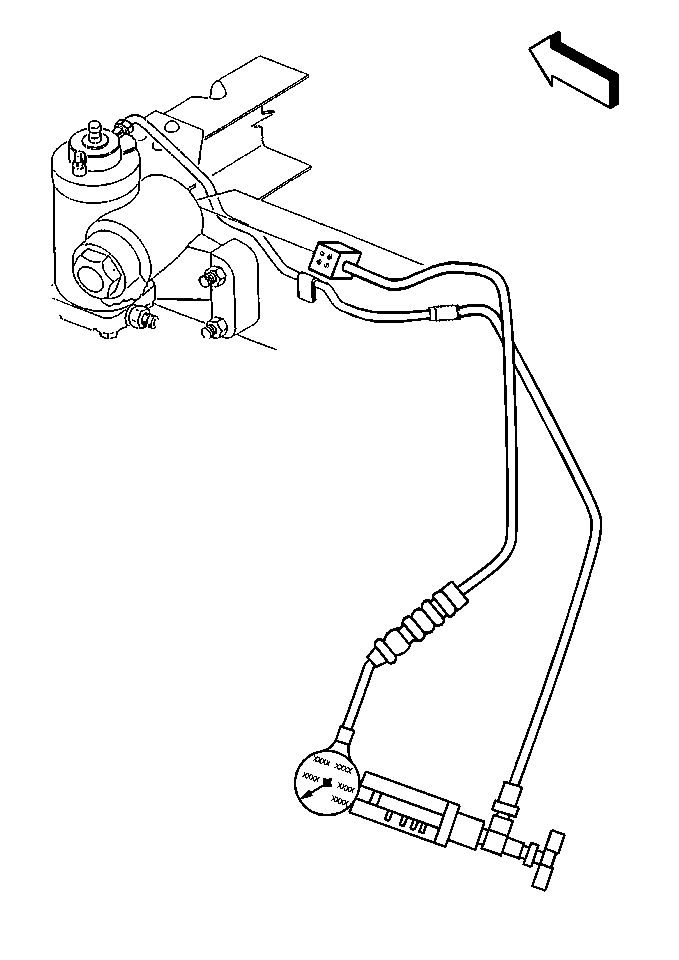Tools Required
J 26487-C Power Steering Analyzer

This test uses J 26487-C and the appropriate adapters. The tool set includes the following components:
| • | The 0-3000 psi pressure gage |
| • | The 0-10 gpm (gallons per minute) flow meter |
| • | The gate valve |
| • | The hoses |
| • | The hose adapters |
Important:
• The steering gear has end limiter valves (end limiters) which
provide an increase in steering effort at the point within 1/3 turn of the
axle stop contact. This is normal operation. • Throughout the following procedure, the letters in parentheses
indicate specific pressures and flows and are given as an aid to document
the values of the pressures and flows.
- Place a container under the power steering hoses at the power steering hose bulkhead in order to catch the fluid when disconnecting or connecting the hoses.
- Disconnect the pressure hose snap-to-connect fittings at the power steering bulk head.
- Bleed the power steering system if the analyzer has never before been used. Ensure that the analyzer gate valve remains open during the procedure. Refer to Power Steering System Bleeding .
- Run the engine at idle speed.
- Partially close the gate valve in order to build up to 700 psi.
- Compare the values of flow (A) and flow (C).
- Complete the following steps in order to obtain the pressure (D):
- Compare the pressures (D) to the specified pressures.
- Increase the engine speed from idle to approximately 1500 RPM.
- Compare the values of flow (A) and flow (E).
- Use a non-hardened 1.3 cm (0.5 in) steel spacer on the steering gear held in place by a long handle in front on the steering stops to prevent the end limiters from being tripped.
- Have an assistant lightly turn the steering wheel into the left steering stop and then the right steering stop.
- Record the pressure and flow (F). Pressures developed at both stops should be the same as maximum pump output (D).
- Replace the steering gear because of leaks if the pressure does not reach maximum output or if the flow does not drop below 1 gpm. Refer to Steering Gear Replacement .
- Observe the pressure gage.
- Inspect the system oil for contamination.
Connect the analyzer hoses to the adapters.
Record the flow (A) and the pressure (B).
| • | If the flow is less than 2 gpm, the pump may need repair. Continue the test. |
| • | If the pressure is above 200 psi, inspect the hoses for any restriction. |
Observe and record the flow (C).
If the flow (C) is more than 1 gpm smaller the flow (A), replace the pump. Refer to Power Steering Pump Replacement .
| 7.1. | Close the gate for less than five seconds. |
Partially open the gate valve.
| 7.2. | Close and partially open the valve two more times. |
| 7.3. | Observe and record the pressure (D) each time that the gate is closed. |
| • | If the recorded pressures (D) are 100 psi lower than specifications, replace the pump flow control valve. Refer to Power Steering Fluid Reservoir Replacement - Off Vehicle . |
| • | If the recorded pressures (D) are greater than the low specification and vary from each other by more than 100 psi, remove and clean the pump flow control valve. Refer to Power Steering Fluid Reservoir Replacement - Off Vehicle . |
| • | Inspect the system for contamination. Clean the pump and replace the steering gear if the system is contaminated. Refer to Power Steering Fluid Reservoir Replacement - Off Vehicle and End Plate and Rotating Group Replacement and Steering Gear Replacement . |
Observe and record the flow (E).
If the flow (E) varies by more than 1 gpm from the flow (A), then remove and replace the pump flow control valve. Refer to Power Steering Fluid Reservoir Replacement - Off Vehicle .
Caution: This test can be dangerous if not performed correctly. Keep your fingers clear of steering stops and spacer block during this test. Make sure that the spacer block contacts the steering stop squarely. Contact that is not square could break the steering stop or dangerously throw or eject the spacer block.
Notice: Do not hold the steering wheel in the full turn position longer than five seconds. To do so may damage the power steering pump.
Under normal conditions, the needle will move from the normal back pressure reading and then snap back when the wheel is released.
A slow or sticking needle indicates that the rotary valve in the steering gear is sticking.
If contamination exists, the pump must be completely disassembled and cleaned (refer to End Plate and Rotating Group Replacement and Power Steering Fluid Reservoir Replacement - Off Vehicle , and the steering gear replaced.
